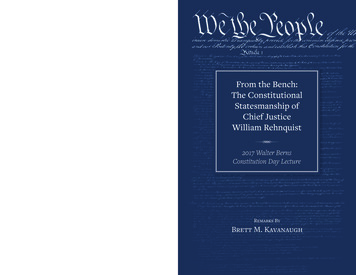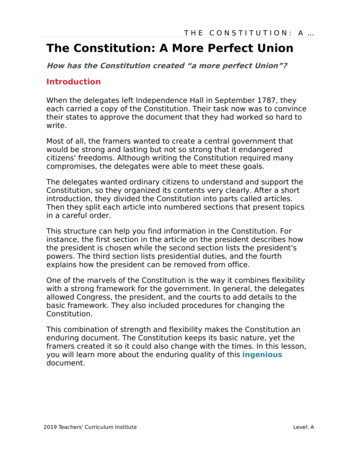
Transcription
From the Bench:The Constitutional Statesmanshipof Chief Justice William Rehnquist2017 Walter Berns Constitution Day Lecture“[William Rehnquist] had a massive and enduring impact on Americanlaw,” including in areas of “criminal procedure, religion, federalism, unenumerated rights, and administrative law.”“[He] would be the first to say that he did not achieve full success on allthe issues he cared about. But it is undeniable, I believe, that he broughtabout a massive change in constitutional law and how we think aboutthe Constitution.”—Brett M. KavanaughOver more than three decades in service to the Supreme Court, Chief Justice William Rehnquist stressed the importance of constitutional structureto preserving individual liberty. Always emphasizing the role of the courtsin maintaining that structure, Chief Justice Rehnquist redirected Americanlaw in key areas—most notably, federalism, congressional power, criminal procedure, and religion. Through his opinions, articles, and books, hedemonstrated how to be a modern constitutional statesman, deserving commemoration and celebration.In honor of the anniversary of the signing of the US Constitution on September 17, 1787, AEI’s Program on American Citizenship marked ConstitutionDay with a lecture by Judge Brett Kavanaugh. Kavanaugh’s lecture was thesixth in a series named for distinguished AEI scholar Walter Berns.From the Bench:The ConstitutionalStatesmanship ofChief JusticeWilliam RehnquistR2017 Walter BernsConstitution Day LectureRemarks ByBrett M. Kavanaugh
From the Bench:The ConstitutionalStatesmanship ofChief JusticeWilliam Rehnquist2017 Walter Berns Constitution Day LectureRemarks byBrett M. KavanaughAmerican Enterprise Institute
2017 by the American Enterprise Institute. All rights reserved.The American Enterprise Institute (AEI) is a nonpartisan, nonprofit, 501(c)(3) educational organization and does not take institutional positions on any issues. The views expressed here arethose of the author(s).
The Walter Berns Constitution DayLecture SeriesA scholar of political philosophy and constitutional law, WalterBerns wrote extensively on issues of American government and itsfounding principles. He authored 10 volumes and published widelyin professional and popular journals and America’s leading newspapers. He was the John M. Olin University Professor Emeritusat Georgetown University and served as a resident scholar at AEI.He taught at Louisiana State University, Yale University, CornellUniversity, Colgate University, and the University of Toronto. Heearned his master’s and doctorate degrees in political science at theUniversity of Chicago. Berns served on the National Council on theHumanities from 1982 to 1988 and on the Council of Scholars in theLibrary of Congress from 1981 to 1985. He was also a delegate to theUnited Nations Commission on Human Rights. He was awardedthe National Humanities Medal in 2005.In September 2011, AEI President Arthur Brooks announcedthat henceforth the Program on American Citizenship’s annualConstitution Day celebration would be named in honor of WalterBerns in appreciation of his scholarly legacy in this field and hismany years of contributing to AEI’s work.iii
From the Bench:The Constitutional Statesmanshipof Chief Justice William RehnquistBrett M. KavanaughSeptember 18, 2017I’m honored to be at the American Enterprise Institute with friendsand scholars I’ve known for many years. This organization has beena place of learning and thinking, and I applaud it for its many continuing contributions to public debate and discourse.I’m honored to speak at a lecture named for Walter Berns. I wasfortunate to become friends with Walter after I was appointed as ajudge on the DC Circuit in 2006. As many of you know, Walter wasa great storyteller, he possessed a keen sense of poker odds, and heloved the Constitution.He had the belief, considered naive in some circles, that themeaning of the Constitution is related to the actual words of theConstitution. To use the title of one of his books, he took theConstitution seriously. Walter exuded wisdom and seriousness ofpurpose. He wrote and taught well. He was a patriot and a greatAmerican. I miss him, and we all miss him in these turbulent times.I’m honored to be here at the Berns Lecture.kWe’re here to celebrate Constitution Day, so I’ll start with a fewwords about the Constitution itself. The Constitution was signedby the delegates at Philadelphia on September 17, 1787—230 yearsago yesterday. The Framers believed that in order to protect1
2 FROM THE BENCHindividual liberty, power should not be concentrated in one personor one institution.To preserve liberty, they created a system of federalism withdual national and state sovereigns. And, furthermore, within thenew national government, they separated the legislative, executive,and judicial powers. As William Rehnquist later stated, the framersdevised two critical innovations for the new national government:a president who is independent of and not selected by the legislative branch and a judiciary that is independent of both the legislative and executive branches.It is sometimes said that the Constitution is a document of majestic generalities. I view it differently. As I see it, the Constitution isprimarily a document of majestic specificity, and those specific wordshave meaning. Absent constitutional amendment, those wordscontinue to bind us as judges, legislators, and executive officials.And if I can be so bold as to suggest an initial homework assignment from my talk today, it is this: In the next few days, block out30 minutes of time and read the text of the Constitution word forword. I guarantee you’ll come away with a renewed appreciationfor the Constitution and for its majestic specificity.We revere the Constitution in this country, and we should. Wealso, however, must remember its flaws. And its greatest flaw wasthe tolerance of slavery. That flaw cannot be airbrushed out of thepicture when we celebrate the Constitution. It was not until the1860s, after the Civil War, that this original sin was corrected inpart, at least on paper, by ratification of the 13th, 14th, and 15thAmendments to the Constitution.But that example illustrates a broader point as well. When wethink about the Constitution and we focus on the specific words ofthe Constitution, we ought to not be seduced into thinking that itwas perfect and that it remains perfect. The Framers did not thinkthat the Constitution was perfect. And they knew, moreover, thatit might need to be changed as times and circumstances and policyviews changed.And so they provided for a very specific amendment process inArticle V of the Constitution. The first 10 amendments, as we all
BRETT M. KAVANAUGH 3know, came very quickly after the new Congress met in 1789. Andthose amendments were ratified in 1791. The 11th and 12th Amendments followed soon thereafter, and that process has continued.Indeed, the amendments have altered fundamental details ofour constitutional structure. The 12th Amendment changed howpresidents and vice presidents are elected. The 22nd Amendmentchanged how long presidents can serve. The 17th Amendmentaltered how the Senate is selected, changing it from a body selectedby state legislatures to a body directly elected by the people. The13th, 14th, and 15th Amendments altered the autonomy of thestates and created new constitutional rights and protections forindividuals against states.Many think we could use a few more constitutional amendments:term limits for Supreme Court justices, term limits for members ofCongress, an equal rights amendment, a balanced budget amendment, abolition of the death penalty. Different people have differentviews. But here, as elsewhere, the Constitution already focused onthe specific question that lies at the foundation of this and so manyother constitutional disputes: Who decides?In this instance, the question is this: Who decides when it is timeto change the Constitution? Who decides when it is time to createa new constitutional right or to eliminate an existing constitutionalright or to alter the structure of the national government? The Constitution quite specifically tells us that the people decide throughtheir elected representatives. An amendment requires the approvalof two-thirds of both houses of Congress as well as three-quartersof the states.But the amendment process is slowed in part because it is sodifficult to garner the congressional and state consensus needed topass constitutional amendments. Because it is so hard, and becauseit is not easy even to pass federal legislation, pressure is often puton the courts and the Supreme Court in particular to update theConstitution to reflect the times.In the views of some, the Constitution is a living document, andthe Court must ensure that the Constitution adapts to meet thechanging times. For those of us who believe that the judges are
4 FROM THE BENCHconfined to interpreting and applying the Constitution and lawsas they are written and not as we might wish they were written,we too believe in a Constitution that lives and endures and instatutes that live and endure. But we believe that changes to theConstitution and laws are to be made by the people through theamendment process and, where appropriate, through the legislative process—not by the courts snatching that constitutional orlegislative authority for themselves.kThat brings me to my primary topic today: William Hubbs Rehnquist. William Rehnquist served on the Supreme Court for 33 years,from 1972 until his death in September 2005. Appointed by President Richard Nixon, he was an extraordinary associate justice from1972 to 1986. Then in 1986, President Ronald Reagan appointedWilliam Rehnquist as the 16th chief justice of the United States. Heserved with distinction in that role for 19 more years. If he were stillalive today, the chief would be 92 years old.William Rehnquist died on Saturday, September 3, 2005. I remember it vividly. At the time, I was working as staff secretary to PresidentGeorge W. Bush. Hurricane Katrina had hit earlier that week. I wasdistressed about how the week had unfolded for the people of NewOrleans and the Gulf Coast, for the country, and for the presidenthimself. I sat late that Saturday night on my couch at home with mythen-two-week-old daughter, Margaret, on my shoulder and a college football game on TV. I got a call on my cell from Dan Bartlett,who was communications director for the president. He said simply,“Rehnquist just died; the president wants to meet tomorrow morning.” I was profoundly sad, but I had no time to dwell on it.As staff secretary, I was responsible for hustling into the WhiteHouse right away, contacting the president, immediately gettingout a presidential written statement, and working with the speechwriters to help prepare the president’s remarks for the followingmorning, which he delivered from the White House at 10:00 a.m.that Sunday morning.
BRETT M. KAVANAUGH 5At that time, John Roberts was the pending nominee for thevacancy created by Sandra Day O’Connor’s retirement earlierthat summer. Roberts had been a Rehnquist clerk and would bea pallbearer at his funeral. When all of us met with the presidentin the Oval Office on Sunday morning, it did not take long for thepresident to settle on nominating John Roberts for the Rehnquistvacancy; he decided that he would worry about the O’Connorvacancy after Roberts was confirmed. The president then publiclyannounced John Roberts’ nomination early on Monday morningbefore we all took off for another trip to New Orleans and theGulf Coast.The enormity of it all—Katrina, Rehnquist, Roberts—still hitsme when I think about it in retrospect. But my focus today isRehnquist. And I’ve chosen to speak about William Rehnquistfor three reasons.First of all, he and Walter Berns were friends, and they shared atremendous appreciation for the Constitution and for each other.So it is appropriate, I believe, to remember William Rehnquist atthe Berns Lecture.Second, it pains me that many young lawyers and law students,even Federalist Society types, have little or no sense of the jurisprudence and importance of William Rehnquist to modern constitutional law.They do not know about his role in turning the Supreme Courtaway from its 1960s Warren Court approach, where the Court insome cases had seemed to be simply enshrining its policy viewsinto the Constitution, or so the critics charged. During Rehnquist’stenure, the Supreme Court unquestionably changed and becamemore of an institution of law, where its power is to interpret and toapply the law as written, informed by historical practice, not by itsown personal and policy predilections.When Rehnquist died, Linda Greenhouse of the New York Times,who would probably not describe herself as an especially big fan ofconservatives, said that Rehnquist had “one of the most consequential” tenures in Supreme Court history. She said that Rehnquist’stenure was marked by “a steady hand, a focus and commitment
6 FROM THE BENCHthat never wavered, and the muscular use of the power of judicialreview.”1 Well said by Linda Greenhouse.And it is incumbent on us, I believe, to remind ourselves of theimportance of Rehnquist and to teach the younger generations toappreciate that legacy as well.Third, I want to speak about William Rehnquist because hewas my first judicial hero. He was not my last judicial hero. But inthe fall of 1987, as I started my first year of law school at Yale LawSchool and as the Bork hearings unfolded that fall, Justice AntoninScalia had been on the Court for only a year and not yet writtenany important opinions as a justice. Justice Clarence Thomas wasnot even a lower court judge yet. My future boss and future mentor, Justice Anthony Kennedy, was still a Ninth Circuit judge. Andthat fall, in the confines of my constitutional law classroom and inother classrooms and other classes later in my law school career, Ibecame exposed to the landmarks of American constitutional law.In case after case after case during law school, I noticed something. After I read the assigned reading, I would constantly makenotes to myself: Agree with Rehnquist majority opinion. Agree withRehnquist dissent. Agree with Rehnquist analysis. Rehnquist makesa good point here. Rehnquist destroys the majority’s reasoning here.At that time, in 1987, Rehnquist had been on the Court for 15 years,almost all of it as an associate justice. And his opinions made a lotof sense to me. In class after class, I stood with Rehnquist. Thatoften meant in the Yale Law School environment of the time that Istood alone. Some things don’t change.For a total of 33 years, William Rehnquist righted the ship of constitutional jurisprudence. To be sure, I do not agree with all of hisopinions. No two people would agree with each other in all cases.Morrison v. Olson in 1988 comes quickly to mind as a Rehnquistopinion I still have some trouble with, and there are others as well.I must also confess that I don’t fully understand why he put goldstripes on the sleeves of his judicial robes in his later years as chiefjustice, but we all have our quirks, I suppose.Rehnquist moreover would be the first to say that he did notachieve full success on all the issues he cared about. But it is
BRETT M. KAVANAUGH 7undeniable, I believe, that he brought about a massive change inconstitutional law and how we think about the Constitution.To begin with, Justice Rehnquist was a judge who contributedto the public debate not only through his judicial opinions but alsothrough his books and articles.He wrote four very readable books: one about the Supreme Court,one about impeachment (which became helpful a little later in hiscareer), one about civil liberties in wartime (which also became helpful), and one about the election of 1876. When asked why he liked towrite books, he said that it was very nice to be able to write something that you don’t have to get four other people to agree with.My Rehnquist story begins with an extraordinarily importantlaw review article Justice Rehnquist wrote in 1976 in the TexasLaw Review. It’s titled “The Notion of a Living Constitution.”2 Inthat article, Justice Rehnquist sought to alter the debate about theproper role of judges, especially on the Supreme Court, in responseto the Warren Court’s jurisprudence and to the changing times andthe changing mores of the people.Rehnquist noted with his characteristically understated wit thata living Constitution was surely better than a dead Constitution.He added that only a necrophile would disagree. In response tothe straw-man argument often raised by opponents of originalism,Rehnquist first noted, importantly, that the principles of the Constitution apply to new activities.In his words, “Merely because a particular activity may not haveexisted when the Constitution was adopted, or because the framers could not have conceived of a particular method of transactingaffairs, cannot mean that general language in the Constitution maynot be applied to such a course of conduct.”3Consistent with Rehnquist’s point there, the Fourth Amendment today applies to searches of cars, even though cars did notexist at the time of the Founding, the First Amendment applies tospeech on the internet, and so on. Put simply, Rehnquist believedthat the constitutional principles do not change absent amendment. But the principles may and indeed must be applied to newdevelopments and activities unforeseen by the framers.
8 FROM THE BENCHThe straw man dispensed with, Rehnquist then addressed whathe described as a quite different living Constitution philosophy,which then was being espoused in certain circles. Under that version of the living Constitution, as Rehnquist described it, nonelected members of the federal judiciary may address themselvesto a social problem simply because other branches of governmenthave failed or refused to do so. These same judges, responsible tono constituency whatever, are claimed as the voice and conscienceof contemporary society, Rehnquist wrote.Rehnquist set forth what he saw as three serious difficulties withthis vision of the living Constitution. First, it misconceives thenature of the Constitution, which was designed to enable the popularly elected branches of government, not the judicial branch, tokeep the country abreast of the times. Second, that vision ignores,Rehnquist said, the Supreme Court’s disastrous experiences inthe past, in cases such as Dred Scott, when the Court embracedcontemporary, fashionable notions of what a living Constitutionshould contain. Third, he said, however socially desirable the policygoals sought to be advanced might be, advancing them through afreewheeling, nonelected judiciary is quite unacceptable in a democratic society.In short, Rehnquist stated, the Constitution does not put thepopular branches “in the position of a television quiz show contestant so that when a given period of time has elapsed and a problemremains unsolved by them, the federal judiciary may press a buzzerand take its turn at fashioning a solution.”4It’s important to emphasize that Rehnquist’s notion of the Constitution was not one where courts simply deferred to legislativechoices. One early critic of Rehnquist in 1976 wrote that Rehnquist’s vision of the Constitution meant that in cases involvingconflicts between the government and individuals, the governmentwould win.5 That was wrong. That was not Rehnquist’s philosophyor the point of his article.His point was that it was not for a judge to add to or subtractfrom the individual rights or structural protections of the Constitution based on the judge’s own views.
BRETT M. KAVANAUGH 9I read Rehnquist’s Texas Law Review article when I was a firstyear law student, and it’s impossible to overstate its significanceto me and how I first came to understand the role of a judge inour constitutional system. The article stood then as a lonely voiceagainst the vision of the Supreme Court that was being promotedby most Supreme Court justices and by virtually all law professorsat the time.In my view, Rehnquist’s article is one of the most importantlegal articles of all time. It is short and straightforward, and if I canbe so bold as to give you a second reading assignment from thislecture, it is to read Rehnquist’s article titled “The Notion of a Living Constitution.”Of course, he was not only a scholar. He was a jurist. He put hisviews not only into law reviews and books but also into the UnitedStates Reports. I can’t possibly touch on all or even most of his enormous body of judicial work, but I’m going to briefly summarize fiveareas of Rehnquist’s jurisprudence where he applied his principlesand where he had a massive and enduring impact on American law:criminal procedure, religion, federalism, unenumerated rights, andadministrative law.The first topic is criminal procedure, including the death penalty. When I clerked for Justice Kennedy in 1993–94, the Kennedyclerks as a group had lunches with each of the other justices atsome point during the year. When we had our lunch with ChiefJustice Rehnquist, one of my Kennedy co-clerks (and it wasn’t NeilGorsuch) somewhat boldly asked the chief justice what kinds ofcases he liked the most. And without missing a beat, the chief saidcases involving the rights of criminal defendants.In a 1985 New York Times interview,6 Rehnquist said that one ofthe achievements during his first 13 years on the Court had been tocall a halt to the number of sweeping rulings of the Warren Court.In the field of criminal procedure, Rehnquist fervently believedthat the Supreme Court had taken a wrong turn in the 1960s and1970s, and nowhere was he more forceful on this point than inthe Fourth Amendment context, especially in cases involvingviolent crime and drugs. He led the charge in rebalancing Fourth
10 FROM THE BENCHAmendment law to respect the rights of the people and victims ofviolent crime as well as of criminal defendants. He wrote the 1983opinion in Illinois v. Gates, still cited often today, that made theprobable cause standard more flexible and commonsensical. Hewrote opinions expanding the category of special needs searches,those that could be done without a warrant or individualized suspicion—for example, the 1990 case of Michigan v. Sitz upholdingdrunk-driving roadblocks.Perhaps his most vehement objection to Warren Court FourthAmendment law concerned the exclusionary rule by which courtswould exclude probative evidence from criminal trials because thepolice had erred in how they obtained the evidence. At the timeRehnquist took his seat on the Court in 1972, Mapp v. Ohio, whichhad extended the exclusionary rule to states, was only 10 years old.But Rehnquist was obviously not sold on it. In his 1979 separateopinion in California v. Minjares, Rehnquist called for the overruling of Mapp. He disagreed with the idea that, in his words, “‘thecriminal is to go free’ solely because of a good-faith error in judgment on the part of the arresting officers.”7 This judge-createdrule in Rehnquist’s view was beyond the four corners of the FourthAmendment’s text and imposed tremendous costs on society.He advocated for other remedies for police mistakes or misconduct, but he believed that freeing obviously guilty violent criminalswas not a proper remedy and, in any event, was surely not a remedyrequired by the Constitution. Rehnquist of course did not succeedin calling for the overruling of the exclusionary rule, and not manypeople today call for doing so, given its firmly entrenched positionin American law.But it would be a mistake to call his exclusionary rule project afailure. On the contrary, Rehnquist dramatically changed the law ofthe exclusionary rule. Led by Rehnquist, the Supreme Court created many needed exceptions to the exclusionary rule that endureto this day. Probably the most notable is the 1984 decision of UnitedStates v. Leon, where the Court held that exclusion would rarely beappropriate if an officer conducted a search with a warrant in goodfaith. And there were many others.
BRETT M. KAVANAUGH 11The same basic story occurred with Miranda v. Arizona. JusticeRehnquist was for years the most vehement critic of Miranda, andhe wrote numerous opinions limiting its application. For example,in New York v. Quarles in 1984, Rehnquist wrote for the Court thatthere was a public-safety exception to Miranda so that Mirandawarnings need not be given in situations where the officers soughtinformation to protect the public from harm.To this day, as with the exclusionary rule, courts apply Mirandabased on many precedents that Rehnquist authored. Those precedents and cases authored by Rehnquist have ensured that Mirandais applied in (Rehnquist would say) a more commonsensical waythat is closer to the proper constitutional meaning and that avoidsthe extremes of the Warren Court holdings.The story is similar with respect to the death penalty. Just a fewdays after Rehnquist took his seat on the Supreme Court in January 1972, the Court heard argument in a series of cases, knownby the lead case Furman v. Georgia, about the constitutionality ofthe death penalty. The Court that June ultimately struck down bya five-to-four decision all of the death penalty laws in the UnitedStates. Rehnquist dissented, joined by Chief Justice Warren Burgerand Justices Harry Blackmun and Lewis Powell. Burger wrote themain dissent, but Rehnquist’s dissent also packed a punch.A mere five and a half pages in the US Reports deftly summarize the fundamental problems he saw in the core of the Court’sholding. As he explained, the decision “brings into sharp reliefthe fundamental question of the role of judicial review in a democratic society.”8 He continued, “The most expansive reading ofthe leading constitutional cases does not remotely suggest that thisCourt has been granted a roving commission, either by the Founding Fathers or by the framers of the Fourteenth Amendment, tostrike down laws that are based upon notions of policy or morality suddenly found unacceptable by a majority of this Court.”9 TheCourt’s ruling, Rehnquist stated, was “not an act of judgment, butrather an act of will.”10But the story did not end there. In the wake of Furman, manystates enacted new capital punishment statutes. In 1976, the Court
12 FROM THE BENCHturned around and upheld many of them. To this day, the deathpenalty remains constitutional. Many judges and justices no doubthave policy or moral concerns about the death penalty. But Rehnquist’s call for the Court to remember its proper and limited role inthe constitutional scheme has so far proved enduring in the deathpenalty context.In short, today’s constitutional jurisprudence in the field ofcriminal procedure and the death penalty has Rehnquist’s fingerprints all over it. Those are the cases that Rehnquist cared aboutmost. That was his mission primarily, and it is fair to say that hehad a dramatic and enduring effect on the course of constitutionallaw in those areas.The second topic is religion. When Justice Rehnquist joinedthe Supreme Court in January 1972, the Court was in the midst oferecting a strict wall of separation between church and state. Religious institutions could not receive funds from government, evenpursuant to neutral government benefits programs. William Rehnquist was instrumental in reversing that trend. He persuasivelycriticized the wall metaphor as “based on bad history” and “uselessas a guide to judging.”11 Rehnquist said that the true meaning of theEstablishment Clause can be seen only in its history.To be sure, his views of the Establishment Clause did not alwaysprevail. He dissented in a 1985 case, Wallace v. Jaffree, which struckdown a moment of silence law. He asked, reasonably enough, how alaw that allowed students a moment of silence could be deemed anestablishment of religion. He was in dissent in several other casesinvolving prayer in public schools, such as Lee v. Weisman and SantaFe Independent School District v. Doe, involving prayer at graduationceremonies and before football games.Of course, all of those cases involved prayer in the public schoolsetting. And it is fair to say that a majority of the Court throughouthis tenure and to this day has sought to cordon off public schoolsfrom state-sponsored religious prayer. But Rehnquist had muchmore success in ensuring that religious schools and religious institutions could participate as equals in society and in state benefitsprograms, receiving funding or benefits from the state so long as
BRETT M. KAVANAUGH 13the funding was pursuant to a neutral program that, among otherthings, included religious and nonreligious institutions alike.In the critical 1983 case of Mueller v. Allen, he wrote the opinion for a five-to-four Court upholding a Minnesota program thatallowed taxpayers to deduct expenses for the education of theirchildren at private schools, including parochial schools. In 1993,again in an opinion written by Rehnquist in the Zobrest v. Catalina Foothills School District case, the Court reinforced that Muellerholding. And then in 2002, the Court in Zelman v. Simmons-Harris(again, a majority opinion by Rehnquist) upheld an Ohio schoolvoucher program that allowed vouchers for students who attendedprivate schools, including religious schools.In the Establishment Clause context, Rehnquist was central inchanging the jurisprudence and convincing the Court that the wallmetaphor was wrong as a matter of law and history. And that Rehnquist legacy continues, as we see in recent cases such as Town ofGreece v. Galloway, which upheld the practice of prayer for localgovernment meetings. And without the line of Rehnquist casesbeginning with Mueller v. Allen, we never would have seen lastterm’s seven-to-two decision in Trinity Lutheran Church of Columbia v. Comer. In that case, only two justices found an EstablishmentClause pro
iii The Walter Berns Constitution Day Lecture Series A scholar of political philosophy and constitutional law, Walter Berns wrote extensively on issues of American government and its

![Welcome [dashdiet.me]](/img/17/30-day-weight-loss-journal.jpg)








